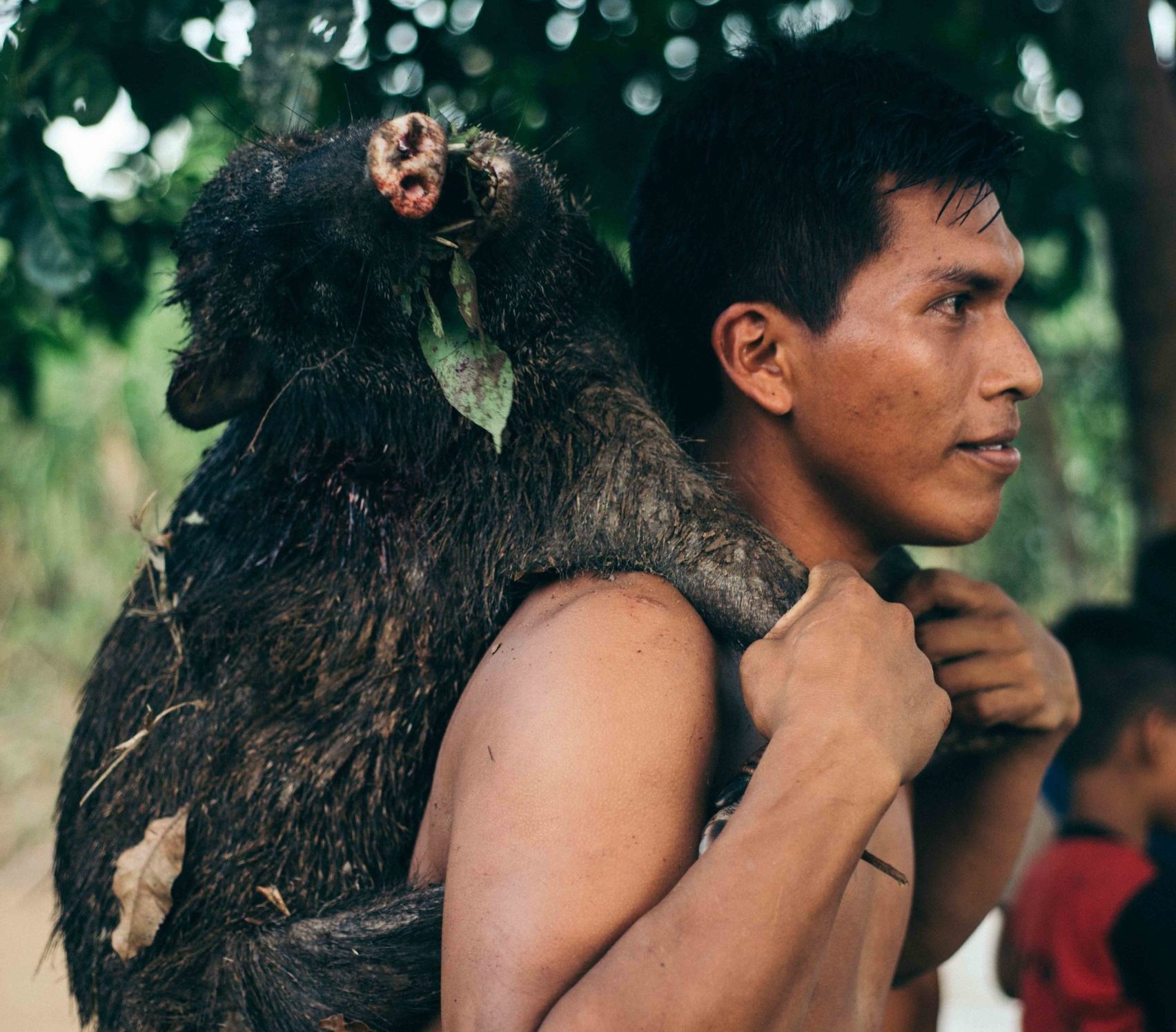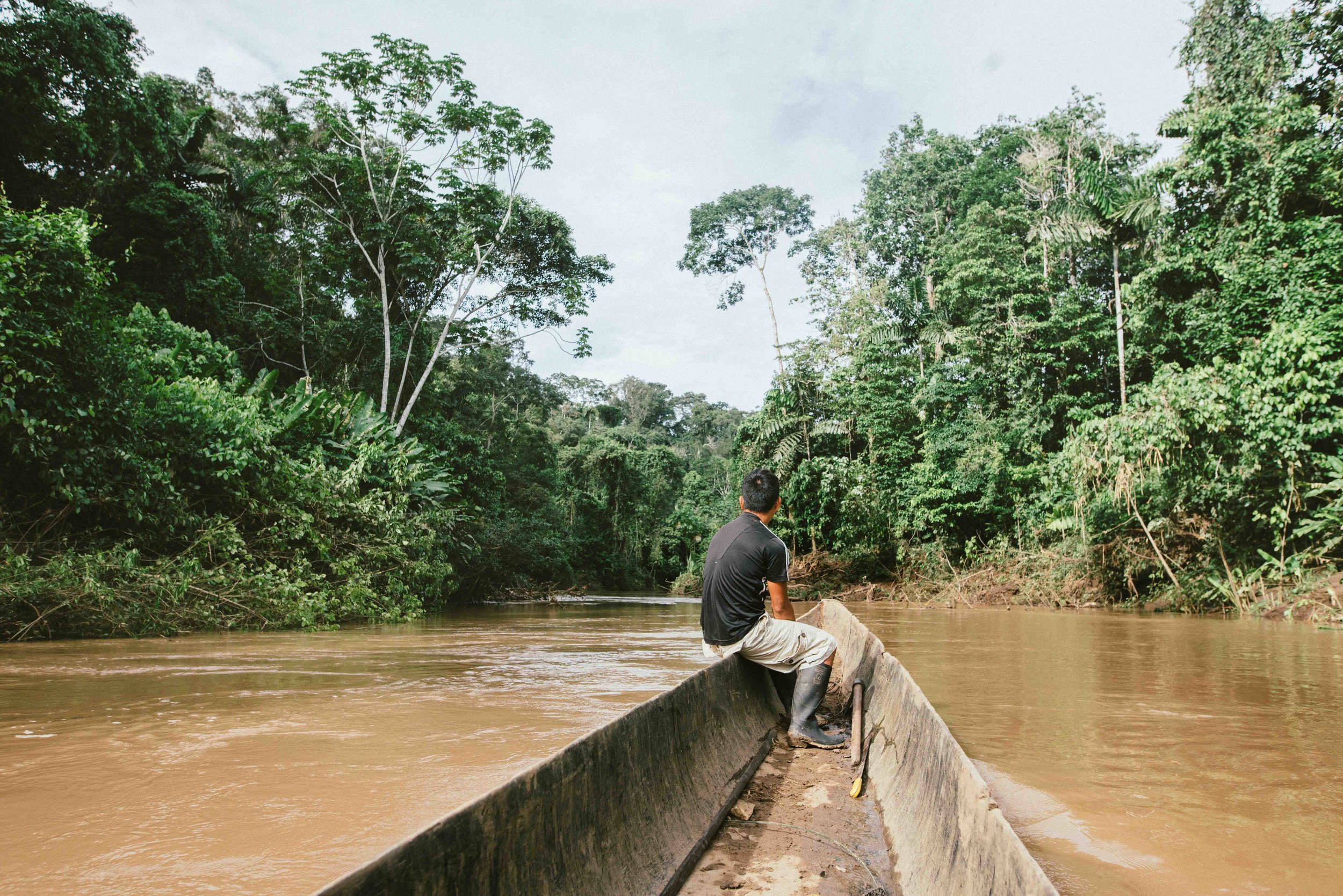In the jungle you either eat to survive or you don’t. I could just follow Emontai all day watching him. Here, I discovered how a man can transform into a beast, an authentic hunter. All of Emontai’s senses are alert and sharp - to hear, to see, to smell, and to feel everything around. He says, "It is like a book, I enter [the jungle] and I can see everything."
Emontai can see all of the animal footprints. By just smelling, he tells us where it went and what it was doing an hour before. We walk for three hours without following a trail, only looking, watching, and interpreting the jungle. In the middle of the jungle there is a creek. We stop to just listen and all of my body can feel this precious life living around us. How small and vulnerable I feel and at the same time, welcomed and sheltered by a strong embrace.

The sound of the rifle shooting explodes like thunder through the depth of the jungle. My eyes and my finger on the trigger are the thin line that separates life from death of an animal, but here inside the jungle everything is a cycle. Life and death go hand in hand and for an instance, the animal that we have inside wakes up and wants to take the life of any unprepared sajino (wild pig).
The return to the house is another adventure. Emontai asks us to find the return trail and all we see are the green plants and the brown soil. Cristina and I look at each other … we are totally lost, but Emontai knows exactly where we are. While we were entering he made many marks in the path, like breaking twigs on plants, and his mind recorded perfectly each tree, creek, event, or path that we crossed during the three hours. Emontai shows us each signal he marked and how to return to the path again. Since this day, I see the jungle completely different. The magic and the mystery here are full of life.

The few elders left, still remember these stories of the killings of the white men that tried to penetrate their territory and convert their hunters and warriors into servants of an absurd religion. I listen to them, and I understand their fear and more than anything, how they felt about their territory being intentionally violated, and how their own people died by the hundreds after the entrance of the whites, and the diseases that they brought.
Memo, a hunter from Acaro, told me that when they were kids, many many many Woarani lived near the rivers like guanganas (wild boars), and when the white men came it was like throwing barbasco in the rivers (a venomous herb used to kill all the fish in the river for hunting). The Woarani dying, dying in hammocks, in their beds while sleeping, like throwing barbasco. We died like guanganas in herds. Now we are few, says Memo. I couldn’t imagine it. I could feel that these last small rainforest communities are the last and ultimate resistance, fighting because their roots still continue deep into the land.

I didn’t understand until a few days ago, how each dollar of petroleum that I put in my auto affects them. Extraction activities generate huge displacements of the indigenous people inside the jungle, and the worst part is that it continues to generate wars between different ethnic groups. They start to kill each other among themselves for a territory which shrinks smaller and smaller. They are the blind and innocent victims of our comfortable lives in the cities. I understand that it’s inevitable that all of these conflicts will happen; this world is advancing exceptionally fast and there is no time to stop and look at the land, look at the sky, and respect everything. It makes me very sad to think that in the next decades they might not be here. Just a memory they would be. Just another story to tell.
Memo still conserves the authenticity and charisma of the Woarani. On the morning of the hunt, he collects his old rifle and straps it with pieces of cloth and hangs it over his shoulder next to his traditional blowgun and prepares his arrows with venom from a plant called curare.
All indigenous that are hunters already know the hunting trail in the jungle. This trail almost always takes them directly to where the animals are reunited to drink water and bathe themselves in the mud. This area is sacred to the indigenous people. I feel very fortunate to be here and see the thousands of footprints and traces imprinted in the mud by the animals that pass by here. But we keep going, we leave the hunting trail and only follow a small mountain that forms a semi-circle.

Memo knows how to imitate the sounds of the animals perfectly, with a folded leaf he imitates the tucan call and all of a sudden a group of almost 15 tucans fly over our heads. I didn’t hear anything other than the call of the tucans and out of nowhere falls a tucan with the arrow blown by the traditional blowgun. How easy to kill and silent. The venom’s effect depends on the size of the animal. A monkey sometimes takes a minute or little less for the venom to kill it. The Woarani measure the time of death by the distance that the animal runs before dying. In my opinion, this is the best form to kill without damaging the meat like a rifle does. The monkey appears like its sleeping you don’t even imagine that it’s already dead. This was our food for the next day.
That night we were invited to participate in a traditional dance, Waorani men and women have their own dance styles. The women dance in the center and the men around them. The dance of the men represents a typical day of hunting. My whole body wants to dance and I enter a trance, like a group of guanganas we are all together. Memo sings from a space deep inside of him, pulling out memories and words, that sound so powerful especially when he imitates the sound of the guanganas from deep inside his chest, while his feet stomp the floor with lots of force. In these moments, I transform into an animal...

